
Packaging worth the paper to print on
By Sarah Harper
General office supplies packaging PaperCheckout - Canadian Packaging - June 2011
Entering a store that sells office supplies is not a frequent occurrence in my life. Because I make every effort to keep my home life as separate as possible from my office existence, printing off anything at home is a rare event indeed. I like things clean and tidy, so I tend to equate just about anything to do with paper as intolerable clutter that must be eliminated at earliest opportunity. But as I was filing my taxes a few weeks ago, my general disdain for loose paper caught up with me in a rather odd way. Just as I tried to get a printout of my tax calculations for future records, I realized that the ink in my seldom-used printer had dried up over the year of inactivity—prompting me to drive to the nearest office supplies outlet to pick up a new ink cartridge for my printer. While I’m not much of a paper person, I do have a very healthy zest and appetite for shopping in general, so instead of just grabbing the cartridge and running off, I made it a point to cruise each and every store aisle, just as I would do in any grocery or other retail store where I find myself. As I wondered around the store, it was impossible not to notice how some of the products were packaged, covering the full range of packaging competence from thoughtful efficiency to wasteful excessiveness and just about everything in between.
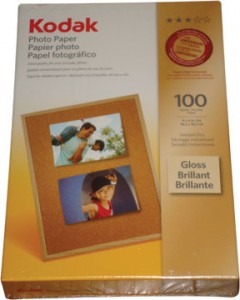 While premium products often require premium presentation on the shelf, that hardly excuses Eastman Kodak Company from excessively overpackaging the 100-sheet bundles of its made-in-Germany Kodak Photo Paper brand. While the primary paperboard box provides a perfect package for such a product in itself, with nice graphics to boot, the extra layer of shrinkwrarp plastic film clinging all around the box seems like a waste of time in terms of consumer convenience and product protection, not to mention the implicit disregard for the whole larger notion of packaging sustainability. Ditto for the plastic peg tab on the back of the package, which was not actually merchandised on a pegboard at this particular location. Why put it there if it’s not needed? It certainly doesn’t seem unreasonable to expect retailers to attach the tabs themselves at the location if they wanted to merchandise the product on a peg board, no? Maybe the fact that this product comes with a limited one-year warranty has something to do with all the packaging excess, but I’m sure there must be a better and simpler way to get the job done.
While premium products often require premium presentation on the shelf, that hardly excuses Eastman Kodak Company from excessively overpackaging the 100-sheet bundles of its made-in-Germany Kodak Photo Paper brand. While the primary paperboard box provides a perfect package for such a product in itself, with nice graphics to boot, the extra layer of shrinkwrarp plastic film clinging all around the box seems like a waste of time in terms of consumer convenience and product protection, not to mention the implicit disregard for the whole larger notion of packaging sustainability. Ditto for the plastic peg tab on the back of the package, which was not actually merchandised on a pegboard at this particular location. Why put it there if it’s not needed? It certainly doesn’t seem unreasonable to expect retailers to attach the tabs themselves at the location if they wanted to merchandise the product on a peg board, no? Maybe the fact that this product comes with a limited one-year warranty has something to do with all the packaging excess, but I’m sure there must be a better and simpler way to get the job done.
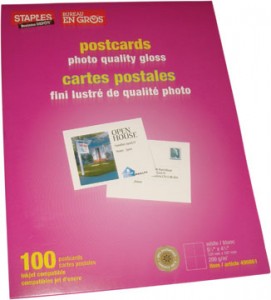 In contrast, The Business Depot, Ltd. strikes a perfect packaging balance for its 100-pack bundles of Staples brand postcards—using a similar resealable paperboard box without the plastic wrapping and tabs, letting a simple sticker sealing the box to let consumers know if the box has already been opened or tampered with in any other way. For someone who does not do a lot of printing at home, these boxes are a perfect packaging solution—allowing you to store the product neatly back in a drawer without any worries about dog-earing, wrinkling and other potential product damage until the next print job comes along. In fact, I’d be willing to pay an extra premium if the regular white printer paper was packaged this way: it would actually save me a little money
In contrast, The Business Depot, Ltd. strikes a perfect packaging balance for its 100-pack bundles of Staples brand postcards—using a similar resealable paperboard box without the plastic wrapping and tabs, letting a simple sticker sealing the box to let consumers know if the box has already been opened or tampered with in any other way. For someone who does not do a lot of printing at home, these boxes are a perfect packaging solution—allowing you to store the product neatly back in a drawer without any worries about dog-earing, wrinkling and other potential product damage until the next print job comes along. In fact, I’d be willing to pay an extra premium if the regular white printer paper was packaged this way: it would actually save me a little money
considering how many sheets I had to throw away over time precisely because of accidental product damage while in extended storage.
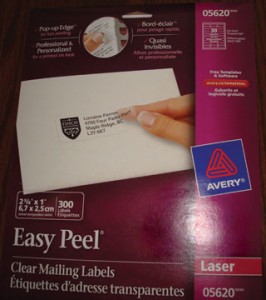 For its part, Avery Dennison Canada Inc. has also done a nice job of keeping its Easy Peel Clear Mailing Labels mailing labels in good condition by using a sturdy, fully-recyclable paperboard envelope—with a triangular peg-hole near the top—to protect the product contents, while also using the envelope’s back panel to display, illustrate and convey all the relevant product information and usage directions in clear, jargon-free manner that will put all first-time users at full ease when purchasing this very handy, easy-to-store kit.
For its part, Avery Dennison Canada Inc. has also done a nice job of keeping its Easy Peel Clear Mailing Labels mailing labels in good condition by using a sturdy, fully-recyclable paperboard envelope—with a triangular peg-hole near the top—to protect the product contents, while also using the envelope’s back panel to display, illustrate and convey all the relevant product information and usage directions in clear, jargon-free manner that will put all first-time users at full ease when purchasing this very handy, easy-to-store kit.
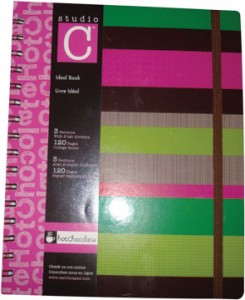 From my personal experience, it seems that suppliers of notebooks put far too much faith in the retailers’ ability to keep their products in pristine condition on the dusty department store-shelves, protected by no more than a simple paper cover sheet, if that. A quick browse through the various notebooks offered at this location only confirmed my suspicion that many of them were sporting damaged covers, dog-eared pages and other signs of varying degrees of deterioration that prompt a shopper to look hard and low on the shelves to find a new notebook of acceptable quality and presentation. So full marks, then, to the Charlotte, N.C.-based Charlotte Pad and Paper for addressing this quality gap, however minor to some, by cleverly utilizing an elastic closure to hold all the pages together and protect all the inside pages from damage from delivery right through merchandising and on to the actual purchase. The brightly-colored, extra-thick cover of the company’s Studio C Ideal Book does a nice job of keeping the elastic perfectly tensioned to do its job, while the cover’s inside pockets—perfect for storing business cards etc.—is a nice value-added packaging bonus that really makes this notebook a very noteworthy improvement over much of its competition.
From my personal experience, it seems that suppliers of notebooks put far too much faith in the retailers’ ability to keep their products in pristine condition on the dusty department store-shelves, protected by no more than a simple paper cover sheet, if that. A quick browse through the various notebooks offered at this location only confirmed my suspicion that many of them were sporting damaged covers, dog-eared pages and other signs of varying degrees of deterioration that prompt a shopper to look hard and low on the shelves to find a new notebook of acceptable quality and presentation. So full marks, then, to the Charlotte, N.C.-based Charlotte Pad and Paper for addressing this quality gap, however minor to some, by cleverly utilizing an elastic closure to hold all the pages together and protect all the inside pages from damage from delivery right through merchandising and on to the actual purchase. The brightly-colored, extra-thick cover of the company’s Studio C Ideal Book does a nice job of keeping the elastic perfectly tensioned to do its job, while the cover’s inside pockets—perfect for storing business cards etc.—is a nice value-added packaging bonus that really makes this notebook a very noteworthy improvement over much of its competition.
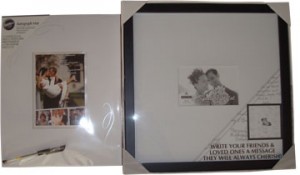 It’s really uncanny how much difference a packaging presentation can make for one very similar, if not identical, paper product such as a signature mat—a popular standby at weddings and other memorable special occasions. Produced by Wilton Industries Inc., the Wilton Autograph Mat is so poorly packaged—utilizing an ultra-thin layer of shrinkwrap film that does nothing to prevent accidental bending and scratching—that the shopper has to go through a whole pile of them on the shelf before finding one with few enough imperfections to make it barely acceptable for use as an attractive keepsake. One would think that any product deemed to be worthy enough of a “special occasion” status would make at least a half-hearted attempt at preserving the product’s integrity, but that hardly seem to be the case here. Conversely, the 4×6 Signature Mat from Malden International Design is an inspired example of how such a product ought to be packaged—pre-framed in an open-faced box, with corner paperboard padding helping ensure tidy presentation right up to the big sign-offs and, ultimately, an elegant presentation of my family memories on the wall for all to admire and reminisce. Well done Malden; Wilton take note!
It’s really uncanny how much difference a packaging presentation can make for one very similar, if not identical, paper product such as a signature mat—a popular standby at weddings and other memorable special occasions. Produced by Wilton Industries Inc., the Wilton Autograph Mat is so poorly packaged—utilizing an ultra-thin layer of shrinkwrap film that does nothing to prevent accidental bending and scratching—that the shopper has to go through a whole pile of them on the shelf before finding one with few enough imperfections to make it barely acceptable for use as an attractive keepsake. One would think that any product deemed to be worthy enough of a “special occasion” status would make at least a half-hearted attempt at preserving the product’s integrity, but that hardly seem to be the case here. Conversely, the 4×6 Signature Mat from Malden International Design is an inspired example of how such a product ought to be packaged—pre-framed in an open-faced box, with corner paperboard padding helping ensure tidy presentation right up to the big sign-offs and, ultimately, an elegant presentation of my family memories on the wall for all to admire and reminisce. Well done Malden; Wilton take note!
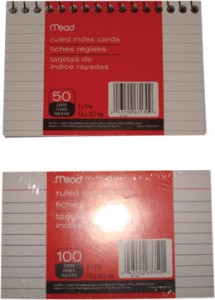 To pursue that “same but different” theme a little further, MeadWestvaco Corporation offers two variations on its Mead Ruled Index Cards—with a 100-pack of loose cards held together by a tight layer of shrinkwrap film, and a 50-pack sprial-bound notebook-style design that allows the pre-perforated cards to be easily torn out of the bundle once they have served their purpose. While the second version is far more preferable for a neatness freak like yours truly, MeadWestvaco deserves to be commended for offering consumers the choice and flexibility of having more than one option available, as well as for helping me actually quantify the price of tidiness. Sixty cents more for half as many cards may seem a little steep to some, but in this corner, it’s a fair price for keeping thing neat and organized, with all the priceless peace of mind that comes with it.
To pursue that “same but different” theme a little further, MeadWestvaco Corporation offers two variations on its Mead Ruled Index Cards—with a 100-pack of loose cards held together by a tight layer of shrinkwrap film, and a 50-pack sprial-bound notebook-style design that allows the pre-perforated cards to be easily torn out of the bundle once they have served their purpose. While the second version is far more preferable for a neatness freak like yours truly, MeadWestvaco deserves to be commended for offering consumers the choice and flexibility of having more than one option available, as well as for helping me actually quantify the price of tidiness. Sixty cents more for half as many cards may seem a little steep to some, but in this corner, it’s a fair price for keeping thing neat and organized, with all the priceless peace of mind that comes with it.
Sarah Harper is a pricing and promotions manager at a leading national supermarket chain living in Milton, Ont.
Advertisement

